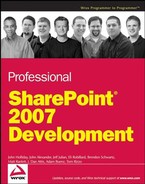 Building Rich Portal Solutions on SharePoint
by Tom Rizzo, Adam Buenz, J. Dan Attis, Matt Ranlett, Brendon Schwartz, Eli Robilla
Professional SharePoint® 2007 Development
Building Rich Portal Solutions on SharePoint
by Tom Rizzo, Adam Buenz, J. Dan Attis, Matt Ranlett, Brendon Schwartz, Eli Robilla
Professional SharePoint® 2007 Development
- Copyright
- Dedication
- About the Authors
- Credits
- Acknowledgments
- Foreword
- Introduction
- The Microsoft Application Platform and SharePoint
- MOSS 2007 Overview for Developers
- The SharePoint User Experience
- WSS v3 Platform Services
- Programming Windows SharePoint Services
- A Sample Collaboration Solution
- RSS, Blogs, and Wikis
- Building Personalized Solutions
- Using Enterprise Search
- Using the Business Data Catalog
- Building Document Management Solutions
- Building Records Management Solutions
- Building Web Content Management Solutions
- Electronic Forms in MOSS 2007
- Building Workflow Solutions
- Business Intelligence and SharePoint Server 2007
- Using the Microsoft Visual Studio 2005 Extension for Windows SharePoint Services 3.0
- Installation Requirements
- Building a Custom Solution Using the VSeWSS
- Using VSeWSS to Build Site Definitions and Custom Modules
- Using VSeWSS to Build Content Types
- Building a Custom Content Type Using VSeWSS
- Using VSeWSS to Build List Definitions
- Using VSeWSS to Build Web Parts
- Leveraging the SharePoint Solution Generator
- Summary
- Index
8.1. Building Rich Portal Solutions on SharePoint
Portals were originally created by providers of large public Internet services, such as Yahoo and MSN, that manage thousands of content-rich sites under a common umbrella. However, as corporate intranets and extranets have become more complex, portals have become popular aspects of company infrastructure. They provide employees and business partners with easy access to information such as company news, contact lists, documents, and reports. In addition, portals serve as entry points to back-end business services such as purchasing, manufacturing, and accounting. Human resources departments are deploying portals that provide convenient access to public documents such as the employee handbook as well as private access to an employee's own records. Furthermore, many HR portals include self-help features for tasks such as updating information related to health insurance and retirement plans.
As the needs of these applications have grown, the applications running these sites have grown. They have become easier to customize and have started to use more powerful user data. The portals used by many companies take the form of many different applications today as follows:
Standard sets of web pages
Content Management Servers (CMS systems)
User portal-based applications
Internal portals for company use
External portals for business-to-business use
Although it is difficult to be everything to everyone, Windows SharePoint Services provides a framework that Office SharePoint Server builds upon to build these types of portal systems. One of the most important features needed for a portal are the user profiles. Each user has a set of profile data that can be used to display information to other users or determine which content the user should see. The profile data can be managed easily from a central location and can be shared across multiple web applications. This data can be imported from other sources or used from a central source.
SharePoint also includes the My Site feature that enables each user to create a personal site with public and private views. This enables users to save, manage, and share information much more conveniently than older file-sharing techniques allowed. This chapter looks at how to manage My Site with the user interface as well as through the object model.
To make the sites dynamic, SharePoint uses audiences to determine the correct content to display to the right users. In addition to audiences, you can use specific Web Parts to show data about yourself and other Colleagues. This allows you to set up a group of users that match a certain profile to be shown the data they need immediately.
-
No Comment